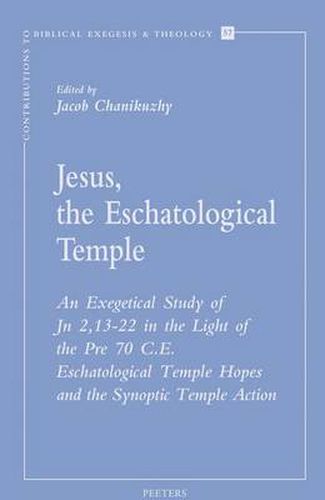Readings Newsletter
Become a Readings Member to make your shopping experience even easier.
Sign in or sign up for free!
You’re not far away from qualifying for FREE standard shipping within Australia
You’ve qualified for FREE standard shipping within Australia
The cart is loading…






The ‘temple action’ of Jesus, popularly known as ‘temple cleansing,’ has been subjected to meticulous studies. Nevertheless, studies focussing on the Johannine version of the ‘temple action’ are surprisingly very few. The present work concentrates on the Johannine ‘temple action’ (Jn 2,13-22). The unique contribution of this book is that it has ventured to situate the ‘temple action’ of Jesus in contexts which have hitherto not been adequately considered in this respect. These significant contexts include the Pre-70 C. E. Jewish hopes concerning the eschatological temple and the Post-70 C.E. private, apocalyptic, rabbinic and political responses to the destruction of the Jerusalem temple. By placing the ‘temple action’ in the aforesaid contexts, and also in the context of the synoptic versions of the ‘temple action,’ this study clarifies why John presents Jesus as the temple, and what it means to say that Jesus’ body is the temple. These contexts, besides throwing light to the ‘temple action’ of Jesus, also turn to be a powerful key to unravel the subtle nuances of much of the Johannine material.
$9.00 standard shipping within Australia
FREE standard shipping within Australia for orders over $100.00
Express & International shipping calculated at checkout
Stock availability can be subject to change without notice. We recommend calling the shop or contacting our online team to check availability of low stock items. Please see our Shopping Online page for more details.
The ‘temple action’ of Jesus, popularly known as ‘temple cleansing,’ has been subjected to meticulous studies. Nevertheless, studies focussing on the Johannine version of the ‘temple action’ are surprisingly very few. The present work concentrates on the Johannine ‘temple action’ (Jn 2,13-22). The unique contribution of this book is that it has ventured to situate the ‘temple action’ of Jesus in contexts which have hitherto not been adequately considered in this respect. These significant contexts include the Pre-70 C. E. Jewish hopes concerning the eschatological temple and the Post-70 C.E. private, apocalyptic, rabbinic and political responses to the destruction of the Jerusalem temple. By placing the ‘temple action’ in the aforesaid contexts, and also in the context of the synoptic versions of the ‘temple action,’ this study clarifies why John presents Jesus as the temple, and what it means to say that Jesus’ body is the temple. These contexts, besides throwing light to the ‘temple action’ of Jesus, also turn to be a powerful key to unravel the subtle nuances of much of the Johannine material.